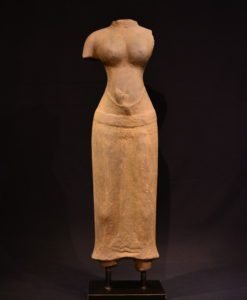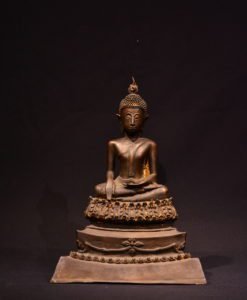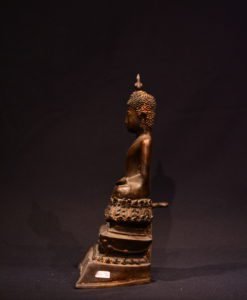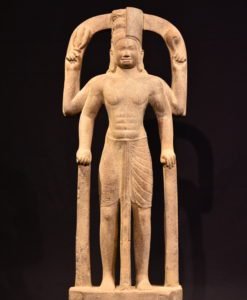Mandalay Period Bronze Relief: Birth of the Buddha – A Masterpiece of Burmese Art
This exquisite bronze relief, framed in wood, captures one of the most significant moments in Buddhist history — the birth of the Buddha. Originating from Burma’s Mandalay period (1857–1885 CE), this relief is a striking example of the intricate craftsmanship and spiritual depth that defined Burmese art during this era. It offers a fascinating glimpse into the narrative depictions of Buddhist stories, showcasing the reverence and dedication to the Buddha’s miraculous birth.
ITEM DESCRIPTION
A Symbolic Representation of the Birth of the Buddha
The relief masterfully illustrates the birth of Siddhartha Gautama, who would later become the Buddha. The scene is delicately framed within a rectangular structure, emphasizing the sacredness of the moment. At the center of this narrative, the figure of a woman—likely the Buddha’s mother, Queen Maya—can be seen, symbolizing the purity and miraculous nature of the event. According to Buddhist tradition, the birth of the Buddha was extraordinary: he was born from his mother’s side and immediately took seven steps, each marking his path to enlightenment. The relief, though relatively shallow, brings this moment to life with its detailed, yet stylized figures, exuding both grace and power.
Mandalay Period Artistic Influence
The Mandalay period, the last great period of Burmese royal art, was heavily influenced by Theravada Buddhism, with art playing a crucial role in the propagation of Buddhist teachings. This relief is a testament to the elaborate ornamentation and intricate craftsmanship typical of the period. Mandalay artists often used bronze to create detailed sculptures and reliefs, reflecting both the religious and cultural importance of the time. The intricate figures, especially those surrounding the central image of the Buddha’s birth, showcase the Mandalay artisans’ commitment to producing highly detailed and meaningful religious narratives. These works were often commissioned by the royal court or produced for display in religious spaces such as temples and monasteries.
The figures in the relief, although stylized, represent a significant spiritual connection to Burmese culture, reflecting the royal patronage of art during this period. While the frame around the relief is simple in design, it serves to highlight the delicate craftsmanship of the bronze panel, ensuring that the relief is preserved and appreciated for generations to come.
The Spiritual Significance of the Nurturing Mother
Queen Maya, depicted in this scene, holds a central role in the story of the Buddha’s birth. In Buddhist tradition, she is venerated as the mother who gave birth to the enlightened one. Her figure, though simplified in relief, radiates the importance of motherhood and nurturing. As she is surrounded by attendants, the piece underscores the spiritual and miraculous nature of the birth event. In the broader context of Burmese religious art, such depictions were used to instruct and remind viewers of the life of the Buddha, his divine origins, and the path to enlightenment.
Craftsmanship and Condition
This bronze relief panel is a fine example of Burmese metalwork from the Mandalay period. The smooth, polished surface of the bronze has retained its natural color and shine, giving it a timeless appeal. The absence of patina on the surface further reflects the exceptional care with which the piece has been maintained. The relief is in remarkable condition, with no visible signs of wear, making it an excellent addition for collectors or those interested in acquiring a piece of Burmese history.
The wooden frame surrounding the relief, though unadorned, serves as a practical feature, offering both aesthetic balance and protection to the delicate bronze relief. Its simplicity ensures that the focus remains on the detailed craftsmanship of the relief itself, without distraction.
A Statement Piece for Collectors and Enthusiasts
For antique collectors, spiritual art enthusiasts, and those passionate about Burmese history, this bronze relief serves as an exceptional example of Mandalay-period craftsmanship. It provides not only a visually stunning piece of art but also a rich narrative steeped in Buddhist symbolism. Its historical significance, combined with its remarkable preservation and craftsmanship, makes it an invaluable addition to any collection.
Whether displayed in a personal gallery or as part of a broader collection of Southeast Asian art, this bronze relief depicting the birth of the Buddha will undoubtedly stand as a testament to the enduring spiritual and artistic heritage of Burma. With its compelling historical story, it is a unique piece that offers both beauty and profound meaning.
References:
-
“Burmese Art and Culture: A History of Myanmar Art.” Asia Society. Available at: https://asiasociety.org/burmese-art
-
“The Mandalay Period and its Artistic Influence.” The Metropolitan Museum of Art. Available at: https://www.metmuseum.org/mandalay-period-art
-
Hla, Maung. (2004). Art and Architecture of Myanmar: A Study of the Mandalay Period. Yangon: Myanmar Publishing House.
-
“Theravada Buddhism in Art and Iconography.” The British Museum. Available at: https://britishmuseum.org/theravada-buddhism-art
Origin: Myanmar
Period: Mandalay
PRODUCT DETAIL
Medium: Bronze
Dimensions:
Height – cm
Length – cm
Wide – cm
Condition Report: –
Please keep in touch for Price and more information: Mallika1013@gmail.com




















